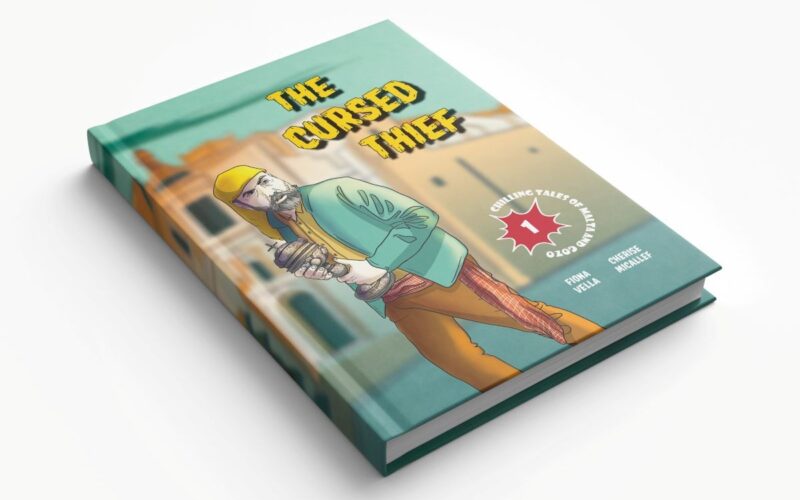In a cluster of offices at Heritage Malta’s headquarters in Bighi, a small group of people are busy creating books. There are editors, proofreaders, designers, and illustrators – the team behind each one of the 35 books, more or less, issued by Heritage Malta Publishing every year.

Their driving force is Godwin Vella, whose passion is evident in the way he speaks about each publication and whose unwavering conviction that books are here to stay is somewhat contagious.
“Nothing will ever replace books,” Godwin declares adamantly. “They have withstood the test of time and will keep doing so. The oldest known book that describes Malta was written by Quintinus in 1536, and it is still consulted. Books are the ultimate medium through which knowledge is shared with the public, and the public will always be fascinated by them. Digital and hard copies complement – not replace – each other. In fact, those who issue both do not report decreases in the sale of the physical versions. Of course, in Heritage Malta’s case, we need to publish books to remain academically credible if for no other reason. Books will always remain the backbone of the academic qualifications of an organisation, no matter what technological improvements occur.”
“With books being sent to print every single month and a very heartening readership, the future of Heritage Malta’s publishing arm looks promising.”
Heritage Malta’s publishing arm, in fact, was created as a natural course of action around 14 years ago. The first book was an academic publication about Ġgantija, meant to complement an exhibition about some newly discovered prints and drawings of the megalithic site. At the time, the publishing unit hadn’t yet been properly set up – it was more of a shared effort across different departments within the agency. The publishing unit started taking shape from then onwards, with a team built slowly and specifically for it and that team being based at Head Office as of 2014.
Nowadays, the books produced by Heritage Malta Publishing act as an extension of the interpretation of each museum and site under the agency’s care and are targeted at a varied readership.

The youngest readers are catered for with a series of colouring books depicting scenes around the Maltese Islands. Aptly named ‘Colouring Malta and Gozo’, the series has had three issues up till now.
For slightly older children, there is the ‘Life With …’ series, always featuring an animal that tells a story. With eight publications so far, each book in the series is site specific or region specific. The main learning outcomes of each site or region are discussed with the respective curator, and then a story revolving around those outcomes is created. Each publication doubles up as a fully fledged activity book, with readers encouraged to join dots to create pictures, do word searches and crossword puzzles, colour images, and so on. The next book in the series will feature a talking fish which recounts a story that brings to light several environmental issues pertaining to marine life.

Closely related to the ‘Life With … ’ series is a book titled ‘Fun Discoveries’, aimed at 12-14-year-olds. This publication, handed out to all Heritage Malta Student Passport holders, narrates the history of Malta in an engaging way, each period connected to a different historical site.
Heritage Malta Publishing recently embarked on a new, exciting endeavour – a series of graphic novels called ‘Chilling tales of Malta and Gozo’. Starting off with ‘The Cursed Thief’, recounting the true story of a theft from the Church of St Theresa in Cospicua in 1837, the series is set to recount in comic-book format several factual narratives with a tragic ending. The slaves’ uprising and the story of Dun Mikiel Xerri are among the real-life events that will be narrated in this series.
As Godwin explains, this initiative targets the niche market of comic book enthusiasts – both adults and teens. It is quite a daring endeavour, since the production of graphic novels entails a very long process due to the many illustrations involved. However, judging from the very encouraging response to the first title in the series, the effort will surely be rewarded.

Just a few weeks ago, Heritage Malta Publishing also launched a new series of books, each recounting major events that greatly impacted the course of Maltese history. The first publication in the series focuses on World War II, with the French blockade, the Great Siege, the story of Don Gonsalvo Monroy, and the Ottoman invasion of Gozo in 1551 in the pipeline. The target audience of this series mainly comprises adolescents studying history in secondary school. Interestingly, the series is bilingual, each two-page spread written in both Maltese and English.
Heritage Malta Publishing plans to follow this bilingual trend as much as possible. Godwin acknowledges that publications written in Maltese only are few and far between. “The market is too small. That is the stark reality,” says Godwin.
With books being sent to print every single month and a very heartening readership, the future of Heritage Malta’s publishing arm looks promising. As Godwin explains, “Our ultimate aim in everything we do is to support and reinforce the visitor experience at our sites and museums. Be it the exciting adventure of exploring a Neolithic site for the very first time, or a fascinating exhibition in one of our museums, visitors want a physical reminder of their experience and our publications serve that purpose perfectly.”
Heritage Malta’s publications are available at all sites and museums, and online here.
Read Times2 reviews of recent publications:
1900-1999 in Malta: a history told in 100 moments
50 years of The National War Museum in 50 artefacts
British Army Murals at the Main Guard










